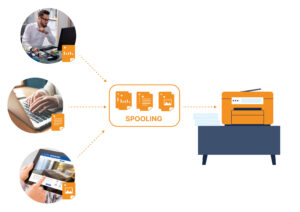High Availability: Highest Levels of Printing Reliability

Increased high availability for the infrastructure is one of the reasons for companies to deploy and manage their enterprise applications from a private cloud. In addition, there are even more advantages: more scalability, reliable security and high flexibility, to name just a few. The private cloud is a major change for organizations. At the same time, more and more companies are leveraging third-party cloud services and replacing their data centers with private cloud solutions. Changing your data center is the perfect opportunity to take a closer look at how to enable printing with more protection against loss of printing to more high availability.
We have published a blog series, which outlines the 5 most important benefits from changing. Part one is titled: IT (and printing as part of that) is a service, services are not run on users’ devices. While the subject of the second article is: The simple relocation of printer drivers into the private cloud. In the third part, we focused on how to reduce printing costs and resources.
In this part, I would like to show you how printing operations can be brought back up and running following a failure thanks to ThinPrint’s high availability and load balancing.
Highest Levels of Printing Reliability with load balancing
With ThinPrint, the print system itself no longer has a single point of failure. ThinPrint servers can be bundled into high availability groups with load balancing. Two or more ThinPrint servers will not only share the print workload but also deliver the jobs as quickly as possible. In addition to monitoring if the servers are generally running, ThinPrint looks at print specific health indicators to determine if a server is deemed to be in good working order or has shut down or reached the customer-defined threshold that disqualifies it from further use until IT has inspected the recorded issues. Once a high availability event is triggered, users’ printer connections are automatically, seamlessly remapped to a different server in the high availability group and users can continue to print without interruption. This is a far more secure approach than the previously used print server clusters or server virtualization based approaches since it covers print specific health indicators and requires no intervention from IT or the user to remap the users’ connections. This approach eliminates all troubleshooting on hundreds or even thousands of user workstations with different operating systems, different base line configurations and individual system issues that all could impact printing. With ThinPrint, a centralized private cloud print system becomes as easy to use and maintain and is as reliable as a public cloud service but remains fully under the organization’s control.
Since printing not only requires that print jobs be reliably processed before being sent to the printer but also need to be received reliably, ThinPrint offers high availability and load balancing for the client side as well. If any of the components installed at the branch/remote site to decompress or decrypt print jobs and to establish reverse tunnels (to eliminate the need for VPNs) become unresponsive, traffic is immediately rerouted to a client component with an identical configuration. These client components can be installed on user workstations, thin clients, remote print servers or ideally be delivered by the ThinPrint Hub in the form of a compact, cost effective and easy to deploy appliance.
With both the private side that processes the print jobs and the branch/remote site highly available and running highly efficiently through load balancing, ThinPrint eliminates all the print specific risks while enabling the full benefits of a centralized private cloud print service.




